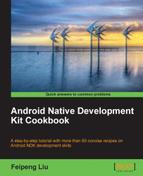This recipe describes how to set up an Android NDK development environment in Mac OS.
Android development requires Mac OS X 10.5.8 or higher, and it works on the x86 architecture only. Ensure that your machine meets these requirements before getting started.
Register an Apple developer account, then go to https://developer.apple.com/xcode/ to download Xcode, which contains a lot of developer tools, including the make utility required for Android NDK development. After the download is complete, run the installation package and make sure that the
UNIX Development option is selected for installation.
As usual, Java JDK 6 or above is required. Mac OS X usually ships with a full JDK. We can verify that your machine has the required version by using the following command:
$javac -version
Setting up an Android NDK development environment on Mac OS X is similar to setting it up on Ubuntu Linux. The following steps explain how we can do this:
- Follow steps 1 to 6 of the Setting up an Android NDK development environment in Windows recipe to install the ADT plugin for Eclipse.
- Download Android SDK from http://developer.android.com/sdk/index.html, then extract the downloaded package.
- Append the following lines to
~/.profile. If the file doesn't exist, create a new one. Save the changes and log out of the current session:export ANDROID_SDK=<path to Android SDK directory> export PATH=$PATH:$ ANDROID_SDK/tools:$ANDROID_SDK/platform-tools
- In Eclipse, select Eclipse | Preferences to open the Preferences window. Select Android from the left panel, then click on Browse to locate the Android SDK root directory. Click on Apply, and then OK.
- In a terminal, start the Android SDK Manager at the
toolsdirectory by typing the commandandroid. Select Android SDK Tools, Android SDK Platform-tools, at least one Android platform (the latest one is preferred), System Image, SDK Samples, and Android Support. Then click on Install. In the next window, read and accept all the license agreements, then click on Install. - Download Android SDK from http://developer.android.com/sdk/index.html, and then extract the downloaded package.
- Change the lines that you appended to
~/.profilein step 3:export ANDROID_SDK=<path to Android SDK directory> export ANDROID_NDK=<path to Android NDK directory> export PATH=$PATH:$ANDROID_SDK/tools:$ANDROID_SDK/platform-tools:$ANDROID_NDK
- Start a new terminal, then go to the
samples/hello-jnidirectory in NDK. Type the commandndk-build. If the build is successful, it proves that the NDK environment is set up correctly.
